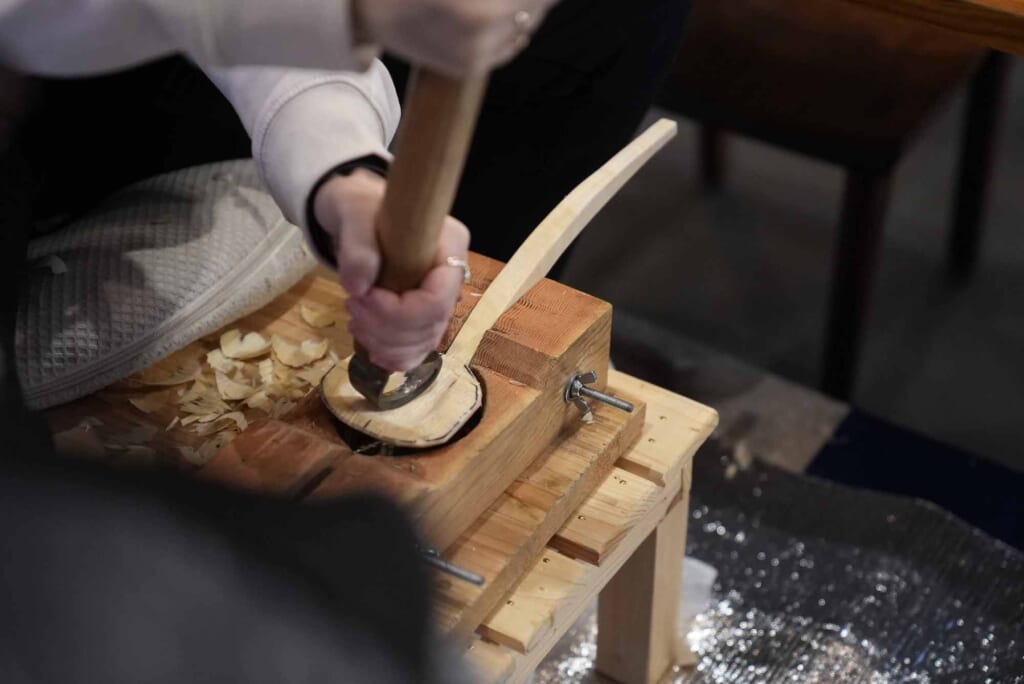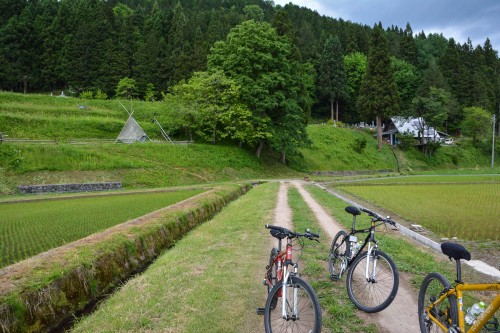This is the second part of our series introducing you to the lesser-known Japan, the New Golden Route, which is now easier to discover thanks to the Hokuriku Arch Pass. The pass costs 24,500 yen per adult when purchased outside of Japan and allows unlimited travel for seven consecutive days on Hokuriku Shinkansen and all the other JR trains operating along the trajectory, starting from Tokyo and covering major stops in Nagano, Toyama, Kanazawa, Fukui, Kyoto, before ending in Osaka.
As the train covered by Hokuriku Arch Pass approaches the Sea of Japan, visitors are welcomed by a region rich in nature and culture.
We cover three stops along the route — Niigata, Toyama, and Ishikawa prefectures — easily accessible with the pass, as well as Gifu prefecture via transfers to other JR lines or buses, and introduce you to the towns of craftsmanship, idyllic nature, traditional Japanese architecture, and a Michelin Star fine dining experience.
JR West also operates tourist trains such as Hanayome Noren in Ishikawa Prefecture and Belles Montagnes et Mer in Toyama Prefecture to help make your train journey even more memorable.
This is part 2 of a 3 part series of articles about the New Golden Route, a part of Japan conveniently accessed by the Hokuriku Arch Pass. To read the other 2 articles in the series, follow these links:
Tsubame in Niigata: Experience the 400 Year Old Metal Crafting Techniques
Tsubame located in Niigata Prefecture is known as a “craftsman town.” The town is particularly famous for its metalworking industry, which has its roots in the art that developed 400 years ago during the Edo Period.
Thanks to the centuries-old experience of the city, Tsubame is now responsible for 90% of the metal tableware sold in the Japanese domestic market. The tableware produced in the city has also achieved global fame and is used for the famous Nobel Prize banquets organized annually in Stockholm, Sweden to celebrate the award winners.



The city, rightfully proud of its craftsmanship heritage, is home to an impressive museum – Tsubame Industrial Materials Museum – where visitors can learn about the craft of metal making and experience the process by participating in workshops.
The museum, in two different buildings, exhibits the metalworking technology used in the city and employs creative display methods such as projection mapping for a captivating experience. There is also a section featuring 5,000 different spoons from across the world, with some dating to the B.C. era.
In the workshop studio, there are multiple options that the visitors can select to have a better understanding of the metalworking techniques. The selection includes making a spoon, hammering a copper cup, and coloring titanium.
| Access and visiting info: Take the Hokuriku Shinkansen from Tokyo Station to Joetsymyoko Station (1h 51 min.). Change to JR Shirayuki Line for Higashi-Sanjo Station (1h 25 min.) and then take JR Yahiko Line for Tsubame Station and walk about 20 min. to the museum. Entrance fee 400 yen for adults at high school age and above. Open daily except on Mondays between 9 am – 4:30 pm (last entry at 4 pm). For more information, visit the Tsubame Industrial Materials Museum. Note: There is a considerably faster way to reach the museum from Tokyo using the Joetsu Shinkansen to Tsubamesanjo Station, but it is not covered by the Hokuriku Arch Pass so there will be an additional cost to travel this way. |
Explore the Fairy Tale Towns of Gokayama in Toyama Prefecture
Gokayama region located in the southwest corner of Toyama prefecture promises an experience rivaling fairy tales. The region is blessed with beautiful nature and is home to 40 picturesque villages scattered along the Shogawa River.
In 1995, two villages of Gokayama together with the nearby Shirakawa-go were added to the UNESCO World Heritage List. The region was recognized as a cultural heritage for its unique rural landscape, Gassho-zukuri houses representing the traditional thatched-roof housing of Japan, that has been passed down for generations.


Ainokura and Suganuma, both earning the UNESCO status, are rich in traditional Gassho-zukuri style houses. Gassho-zukuri houses are built using wooden beams combined to form a steep thatched roof resembling the image of two hands put together. The construction technique used aims to protect the roofs from the heavy snowfall often experienced in the area.
The picture-perfect nature of the region resembles the dreamy alpine sceneries of Switzerland, but the traditional Japanese houses, shops, and cozy eateries create a uniquely Japanese experience.
| Access and visiting info: Take the Hokuriku Shinkansen from Tokyo Station to Shin-Takaoka Station (2h 52min.). Change to the Shirakawa-go World Heritage Bus and get off at Ainokuraguchi bus stop (1h 3min.) for Aoinokura. Suganuma can also be accessed with the same bus (14 min. from Ainokura). |
Visit Hida Takayama in Gifu and Experience Wood Crafting
Hida Takayama located in Gifu prefecture is another wonderful destination to experience the wood culture of Japan. The city is one of the most popular destinations in Japan with its traditional Edo-era street lined by well-preserved traditional houses, famous cuisine of Hida beef, and its proximity to UNESCO World Cultural Heritage, Shirakawa-go and Gokayama.

Hida region is famous for its wood and wood craftsmanship, which is responsible for some of the most beautiful wood carvings that you may likely ever lay your eyes on. The history of the wood carving in the area dates to the late Edo Period (1603-1868) when netsuke, miniature sculptures, were made using yew wood from the mountains of Hida. The beautiful carvings are made just using wood with no additional coloring process.


At Takayama Traditional Culture and Crafts Square, you can try your hand at yew wood carvings (ichii itto-bori), rice scoops (uto shakushi), braided cord (kumihimo), and bamboo lamp making under the guidance of a craftsperson from the area.
Ishikawa: Taste the Kaga Cuisine at 2 Michelin Star Ryotei in Kanazawa
The New Golden Route also includes numerous gourmet stops. Kaga cuisine one can enjoy in Ishikawa prefecture’s Kanazawa city is one of the most memorable ones among these stops. Kanazawa, easily accessible with a single Shinkansen ride from Tokyo under the Hokuriku Arch Pass, is one of the finest cities in Japan offering a perfect fusion of tradition and modern art in settings where every visual detail is carefully thought out. Kanazawa’s exquisite cuisine and its dining venues add to the elegant atmosphere of the city.


Kaga cuisine is primarily based on the local cuisine of Kanazawa and reflects a fusion of the cultures of eastern and western Japan — classified as kaiseki ryori, Japan’s fine dining. This kind of dining experience is so unique that in the older days, one could only experience it by being introduced privately to an establishment offering the experience. Fortunately, kaiseki ryori is an experience more readily accessible nowadays, but it is still as memorable.
Suginoi Honami – two Michelin star Kanazawa establishment – is a perfect place for the experience. The restaurant is located in a mansion dating back to the late Meiji period (1868-1912) and its second-generation owner Koichiro Koshizawa makes sure that the guests learn about and enjoy the food culture of Kanazawa. The restaurant features ingredients procured locally, including fish — thanks to the seaside location of Kanazawa — and vegetables grown in the surrounding mountains. Excessive spicing is carefully avoided to allow the guests to enjoy the cuisine in a relaxed mood, which is also ensured by the Japanese garden located on the premises.
The restaurant is open for lunch and dinner and there are multiple set courses each featuring 7-10 dishes starting at 9,405 yen per person.
| Access and visiting info: Take the Hokuriku Shinkansen from Tokyo Station to Kanazawa Station (2h 30 min.) The restaurant is a 10 min. taxi drive from the station. Lunch service between 11:30 am – 2 pm (last order 1 pm), dinner service between 5 pm – 10 pm (last order at 8 pm). For reservation and course information, visit the Suginoi Honami website. |
How to Get to Niigata, Toyama, Gifu, and Ishikawa Along the Hokuriku Arch Pass Route
Some of the sites listed in this article can be accessed with a single Shinkansen ride covered by Hokuriku Arch Pass whereas some others require transfer to other JR lines or buses.

Hokuriku Arch Pass covers the road less visited and rewards the visitors with UNESCO World Heritage villages, unique rural experiences, exquisite cuisine, and a region rich in traditional craftsmanship. The pass opens the door for the best of Japan has to offer but is yet to be explored by foreign visitors.













No Comments yet!